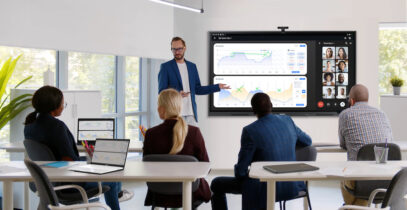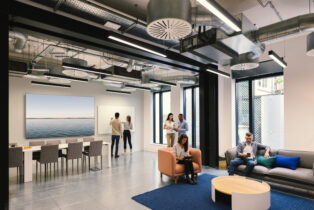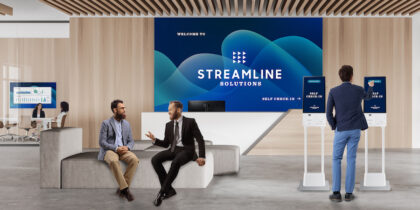The way we learn and collaborate is rapidly evolving in everything from workplaces to classrooms, and Samsung’s innovative and expanding Flip family of interactive displays is adapting to those changes.
First introduced in early 2018, the second generation of the series becoming available — simply called Flip 2 — features enhancements designed to take full advantage of how people of all ages share their thoughts and ideas.
Flip 2 now comes in two sizes — 55-in. and 65-in. — and a series of software and hardware refinements intended to improve the workflow for everything from brainstorming sessions in a tech incubator to teaching for students as young as preschoolers.
Flipping an Old Toolset
The Flip 2 has a familiar look for just about anyone. Many workspaces and learning environments have, for decades, had paper flipcharts in a corner, flanking whiteboards and chalkboards. Flips share the same basic shape, but are entirely digital — using the best aspects of a tool designed for collaboration.
Using paper meant flipping sheets, or tearing them off and sticking them on available walls, or being transcribed to memos so the work could then be shared. It worked, but was also very clunky and impractical. The same goes for whiteboards on easels and walls, with smudgy markers and no way to efficiently save ideas.
The Ultimate Guide to Conference Room Technology
Download this guide to effectively planning your next meeting room technology upgrade. Download Now
All collaboration on the Flip 2 happens on a digital screen. Notes, drawings and even painting can be added with a simple stylus — with as many as four users at once. Any source on the screen — like a document or image — can be annotated with ease. When a meeting or learning session is finished, all the work can be shared instantly via email, network or printer. It can also be ported to a USB drive.
A big attraction of the Flip 2 is the combination of portability, flexibility and ease of use. A Flip 2 — set up very much like an easel — is both small and light enough to move around between meeting, learning and training spaces. The 55-in. version can be pivoted to operate in landscape or portrait orientations.
From inception, the product designers put a premium on delivering a user experience so simplified that training takes minutes and setup time is minimized.
Diverse Enhancements And Additions
The first generation Flip has seen widespread adoption in everything from Fortune 500 offices to classrooms. The second generation versions have a set of new and enhanced features that build on that marketplace momentum and address some of the feedback from users.
Here’s how the Flip 2 has been enhanced:
- The 55-in. version is now complemented by a larger 65-in. version that brings Flip’s ease of use and functionality to a wall-mounted whiteboard design
- Annotation takes just one click on any source material shown on the display, without affecting the original work
- Image editing is easy and flexible
- Working in pen mode has more options, and a brush mode for water color and oil painting has been added
- A built-in browser enables users to directly access websites from the display
- Samsung Workspace allows users to connect PCs to a Flip 2 remotely, meaning a networked PC can stay at a desk while being used for the meeting — removing connection hassles and streamlining workflows
- An optional connectivity tray with HDMI out allows users to push work on a Flip 2 to a separate screen, and also has HDMI in, touch-out and USB compatibility
- IT pros can now manage a fleet of Flips across an enterprise, via MagicInfo RM remote management software, including firmware upgrades, security functions and remote power controls
- The stand for the 55-in. Flip 2 has been slimmed down and ships with no assembly required, and the new 65-in. version has a “no gap” mount that secures the display snug to a wall
Collaboration Redefined
While interactive whiteboards have, for years, been commonplace in collaborative work and learning environments, the Flip series is very different from what’s been seen to date. Here’s how:
- Simplicity: Most interactive whiteboard systems have a learning curve — sometimes a steep one. They’re not operated without training, and put demands on already busy IT resources. The Flip 2 was designed from the ground up to be simple to use, even having a presence sensor that makes the screen ready to go when someone appoaches. A stylus is provided, but a chopstick will work in a pinch. While power users will benefit from very quick training, a Flip 2 can be used by complete novices. Despite that simplicity, the digital canvas delivers 4K UHD visuals.
- Portability: Organizations on tight budgets can use a Flip 2 across multiple meeting or learning spaces, wheeling it between classrooms or from a meeting room to a huddle space
- Flexibility: A Flip 2 looks like an old-school analog flipchart, and can still serve that basic brainstorming function. But it can also be an interactive touchscreen, a presentation tool for PowerPoint decks or a common, easily shared desktop for meeting users who can push materials to the display from a laptop, tablet or even a smartphone.
We’re no longer in a world dominated by top-down management and one-way learning. We collaborate. We share. And we spread the work around. We also archive it — because both time and ideas are precious.
Organizations of all sizes and types are adapting to different ways and styles of meeting, training and learning. The Flip was designed with that in mind, and the second-generation Flip 2 reflects that evolution.
See the original Samsung Flip in action in this short video, or learn more about collaborative digital technologies and how they can transform your business settings with this free white paper.








